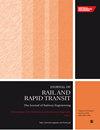研究重载铁路曲线最小半径,改善车轮磨损演变和轮轨接触几何形状
IF 2.1
4区 工程技术
Q3 ENGINEERING, CIVIL
Proceedings of the Institution of Mechanical Engineers Part F-Journal of Rail and Rapid Transit
Pub Date : 2024-05-06
DOI:10.1177/09544097241248205
引用次数: 0
摘要
为确定重载铁路设计中减少车轮磨损的最小合理水平曲线半径,以车轮布置为 C0-C0 的 HXD 机车为研究对象。建立了相应的机车动力学模型和车轮磨损模型。根据特定线路的实测磨损数据,对仿真模型进行了验证,车轮磨损深度的预测误差一般在 0.5 毫米以下。研究并比较了 400∼1000m 半径曲线的车轮磨损演变规律。结果表明,在 400~600m 半径范围内,车轮磨损较大且对曲线半径敏感。当曲线半径从 600 米增加到 1000 米时,车轮平均磨损量会慢慢减少。特别是当曲线半径低于 740 米左右时,轮缘磨损将占主导地位。当曲线半径超过 740 米时,车轮胎面磨损成为主要磨损形式,而车轮轮缘磨损则会明显减少。曲线半径的增加也会改善轮轨等效锥度。如果将最小曲线半径设为 800m,则新轮对与第 1 ∼ 3 次磨损轮对的等效同轴度差异可分别保持在 21%、52% 和 9% 以下。在这种情况下,等效同轴度最接近初始状态并达到稳定状态,不会随着半径的进一步增大而发生显著变化。研究结果验证了《中国重载铁路设计规范》中提出的最小曲线半径,并为该值的确定提供了科学依据。本文章由计算机程序翻译,如有差异,请以英文原文为准。
Investigation of curve minimum radius in heavy-haul railway to improve wheel wear evolution and wheel-rail contact geometry
To determine the minimum and reasonable radius of horizontal curve for reducing wheel wear in heavy-haul railway design, a HXD locomotive with the wheel arrangement of C0-C0 is taken as the research object. Both the corresponding locomotive dynamic model and wheel wear model are established. Based on the measured wear data in a specific line, the simulation model is verified with the prediction error of wheel wear depth below 0.5 mm in general. The wheel wear evolution rules in 400∼1000m radius curves are studied and compared. The results indicate that, the wheel wear is large and sensitive to curve radius within 400∼600 m. The larger radius curve will be helpful to reduce wheel flange contact and wheel wear. For curve radius increasing from 600m to 1000m, the wheel average wear reduces slowly. Especially for curve radius below around 740 m, the wheel flange wear will be predominant. For radius above 740m, the wheel tread wear becomes the main wear form and the wheel flange wear can be reduced significantly. The increase of curve radius will also improve the wheel-rail equivalent conicity. If the minimum curve radius is set as 800m, the equivalent conicity difference between new wheelset and 1st ∼ 3rd worn wheelset can be kept below 21%, 52% and 9% respectively. In this case, the equivalent conicity is closest to the initial state and reaches a steady state, which will not change significantly with the radius further increasing. Viewed from the aspects of reducing wheel wear, avoiding wheel flange contact and keeping conicity stable simultaneously, the minimum radius of horizontal curve should be limited to 800 m. The research results validate the minimum curve radius suggested in Code for Design of Heavy-haul Railway in China, and provide a scientific explanation for the determination of this value.
求助全文
通过发布文献求助,成功后即可免费获取论文全文。
去求助
来源期刊

CiteScore
4.80
自引率
10.00%
发文量
91
审稿时长
7 months
期刊介绍:
The Journal of Rail and Rapid Transit is devoted to engineering in its widest interpretation applicable to rail and rapid transit. The Journal aims to promote sharing of technical knowledge, ideas and experience between engineers and researchers working in the railway field.
 求助内容:
求助内容: 应助结果提醒方式:
应助结果提醒方式:


